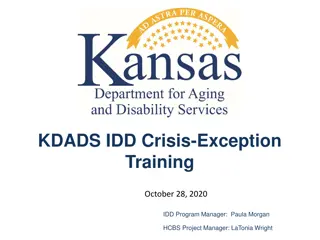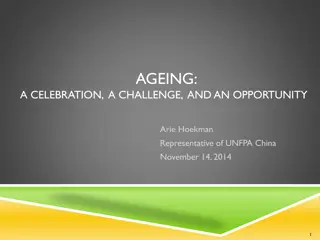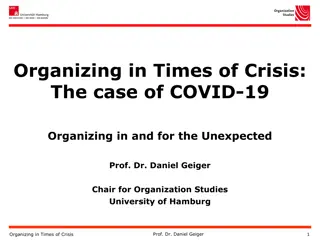Demographic Ageing, Europeanization, and Crisis in Croatia: A Societal Analysis
Analysis of demographic changes in Croatia since the 1990s, including declining population, low employment rates, and high dependency ratios. The study explores the impact of Europeanization, social policy legacies, and pension reforms on the country's welfare system. It discusses the challenges posed by ageing population, recession, and EU membership, highlighting the need for sustainable solutions to address the crisis.
Download Presentation

Please find below an Image/Link to download the presentation.
The content on the website is provided AS IS for your information and personal use only. It may not be sold, licensed, or shared on other websites without obtaining consent from the author.If you encounter any issues during the download, it is possible that the publisher has removed the file from their server.
You are allowed to download the files provided on this website for personal or commercial use, subject to the condition that they are used lawfully. All files are the property of their respective owners.
The content on the website is provided AS IS for your information and personal use only. It may not be sold, licensed, or shared on other websites without obtaining consent from the author.
E N D
Presentation Transcript
Demographic Ageing, Europeanization and the Crisis in Croatia Dr. Paul Stubbs Demographic Change in CEE Vienna, 24 March 2015
Contexts Demographic ageing:declining population since 1991 (war, low birth rates, migration, ...) Low and falling employment rates high youth and long- term unemployment In recession since 2009 (decline in real GDP of 12.5%) EU Member State 1 July 2013 Excessive Deficit Procedure since January 2014 EU-SILC 2013 AROPE Overall: 29.9% - women 30.2%; men 29.6% 65+: 31.9% -women 35.3%; men 26.8% 75+: 36.5% -women 40.4%; men 29.4% Pensions high dependency ratios and low support ratios
Croatia 1st Pillar Pensions Year (end of the period) 1950 Contributors Pensioners Dependency ratio Support ratio 593,102 67,771 11,43% 8.75 1960 912,290 176,978 19,40% 5.15 1970 1,166,088 340,134 29.17% 3.43 1980 1,518,049 438,133 28.86% 3.46 1990 1,682,971 594,339 35.31% 2.83 2000 1,380,510 1,018,504 73.78% 1.36 2010 1,475,363 1,200,386 81.36% 1.23 2011 1,468,133 1,213,121 82.63% 1.21 2012 1,432,740 1,217,692 84.99% 1.18 2013 1,400,631 1,190,815 85.02% 1.18 2014 (Oct.) 1,421,054 1,221,667 85.98% 1.16 2014 (Dec.) 1,397,400 1,223,738 87.76% 1.14
Population projections 2010 2035 2060 TOTAL m. 4.425 4.206 3.862 0-19 0.933 (21.1%) 0.801 (19.0%) 0.701 (18.2%) 20-64 2.727 (61.6%) 2.368 (56.3%) 2.022 (52.4%) 65+ 0.765 (17.3%) 1.038 (24.7%) 1.131 (29.3%) 75+ 0.332 (7.5%) 0.516 (12.3%) 0.641 (16.6%)
Croatian Social Policy Hybrid/patchwork/mixed legacies (self-management and Bismarckism) Captured and clientelistic (war veterans, ethnic Croats from BiH, pensioners...) Late Europeanization and Variegated EU-ization (humanitarianism; Pre-accession JIM; EDP) Welfare Parallelism (Local-National; State-NGO) Embedded neo-liberalism and new conservatism?
Pension Reform 1995 - 2002 Crisis conditions (war, early retirement, Constitutional Court decision) Preferred reform model (World Bank /Chilean model) Technical fix (scenario modelling) in particular domestic and international political conditions Absence of ANY EU position or ILO opposition Implemented Argentinian model mixed three pillar system (PAYG; mandatory savings; voluntary savings) Considerable PR campaign
Sustainability 1st Pillar deficit 2014: 14 b. HRK (EURO 1.84 b) 14 Privileged pension schemes 15% of total, including 72,000 (6%) Veterans of the Homeland War (maximum pension set at double) Equalised retirement age for men and women at 65 by 2030. Between 2031 and 2038 retirement age for men and women gradually raised to 67. Mixed messages on penalities for early retirement lower in pre- election years early retirement used to lower unemployment figures (rising early exits 2012-2014) New in 2014: full pensions for anyone with 41 years contributions. Projections 1st pillar pensions reduced from 10.9% of GDP in 2013 to 7.0% of GDP in 2060 (gap between payments and contributions reduced to 1.4% of GDP)
Adequacy Extremely low aggregate replacement ratio (36% vs EU-28 56%) fall from 47% in 2008 Extremely low and falling benefit ratio 31% - 27% (2030) 22% (2060) Theoretical replacement rates vary considerably but set to fall for all groups First pillar pensions are progressively redistributive 30% of pensioners have less than 25 qualifying years (women 34% , men 26%) Gender pension gap not as large as may be expected Significant numbers of those retired receive no benefits Average monthly pension 2014: 2,240 HRK (EURO 294) War veterans: 5,134 HRK (EURO 675)
Impact of the Crisis Incomes (though not material status) of older people more protected than working-age population Limited and temporary cuts to some privileged pensions (GDP growth and debt reduction triggers ) Indexation formula changes (2010/11 suspended; now favourable to pensioners) Possibility of opting out from second pillar Abandonment (postponement?) of JIM commitment to introduce social pension
Role of the European Union Absent in first wave/radical pension reform JIM social pension and concern with minimum pension levels European semester: concerns regarding both adequacy and sustainability Concern regarding policy uncertainty and inefficiencies Early retirement needs addressing Gender harmonisation too slow Lack of comprehesive active ageing strategy and enabling of longer working life
Conclusions Complex mis-match between externally-driven reform agendas and internal political contingencies No push to renationalise second pillar Little focus on linkage with long-term care needs Gender dimension of pensioner poverty not addressed Renewed discussion on guaranteed minimum income / social pensions























